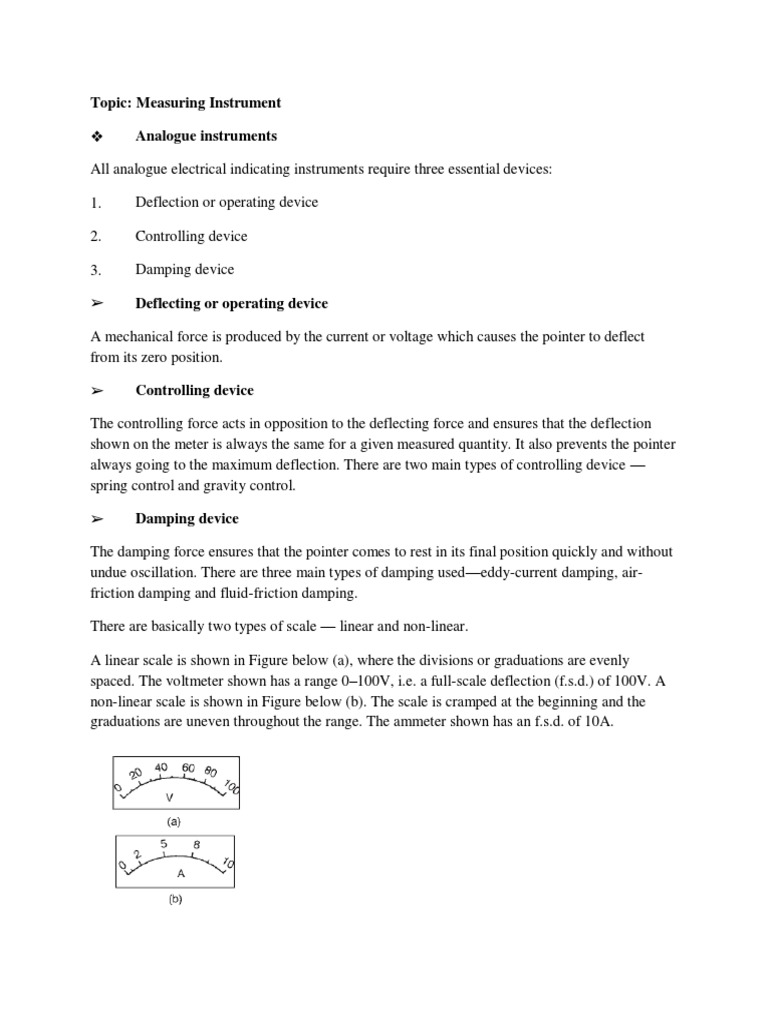The realm of instrumentation in various scientific and engineering domains encompasses a diverse array of devices designed to quantify and analyze physical phenomena. Among these devices, analogue measuring instruments occupy a distinctive position due to their historical significance and fundamental operational principles. This article articulates the advantages of analog measuring instruments, elucidating their operational characteristics, applications, and inherent benefits in comparison to their digital counterparts.
At the outset, it is essential to delineate what constitutes an analogue measuring instrument. These devices are characterized by a continuous representation of information, typically indicated on a calibrated scale through a pointer or needle. Unlike digital instruments, which display numerical values and often involve discrete steps in measurement, analogue instruments provide an unbroken spectrum of readings, allowing for nuanced observations. This fundamental trait lends itself to several advantages that merit thorough exploration.
One primary advantage of analogue measuring instruments lies in their immediacy and intuitive readability. The visual representation of measurements on a dial or scale allows operators to obtain instantaneous feedback about the state of the variable under consideration. For instance, in scenarios where rapid fluctuations in measurement occur, such as monitoring waveforms in electrical circuits or observing pressure variations in a gas tank, the real-time nature of analogue readouts proves invaluable. The dynamic response time of these instruments facilitates instantaneous adjustments and decision-making, which is pivotal in environments that demand quick responses.
Additionally, the versatility of analogue instruments is noteworthy. They are adept at measuring a broad range of physical quantities, including voltage, current, pressure, temperature, and more. This universality makes them indispensable in fields such as physics, engineering, and environmental science. For instance, an analogue voltmeter can effectively measure voltage levels in various contexts, from laboratory experiments to large-scale industrial applications. Their compactness and ease of use further enhance their applicability, especially in field operations where portability is paramount.
The inherent durability of analogue instruments represents another significant advantage. Generally constructed from robust materials, these devices are often resistant to harsh environmental conditions. Unlike digital instruments, which may be adversely affected by temperature extremes or electromagnetic interference, analogue instruments maintain functionality and accuracy in a broader array of settings. This fortitude equips researchers and field technicians with reliable tools that can withstand the rigors of both laboratory and outdoor applications.
Furthermore, the linearity and proportionality inherent in many analogue measuring instruments facilitate intuitive data interpretation. For instance, the scale of an analogue gauge typically progresses in a linear fashion; this allows for a straightforward correlation between the scale division and the measurement value. Such relationships lend themselves well to extrapolation and interpolation in scenarios where intermediate values are requisite. Consequently, the precision offered by these instruments often surpasses numerical readings produced by digital devices, particularly in cases of gradual changes in the measured variable.
In addition to these advantages, analogue instruments often exhibit a superior range of motion in their measurements. The continuous nature of their readings allows for the detection of minute fluctuations that digital instruments may overlook. This sensitivity can be particularly crucial in scientific research, where even the slightest deviations in measurement can have profound implications for experimental outcomes. The ability to gauge such fine variations exemplifies the merits of employing analogue instruments in critical analytical settings.
Moreover, the simplicity of design inherent to many analogue instruments contributes to their ease of maintenance and repair. With fewer electronic components involved, these devices tend to experience a lower frequency of malfunctions relative to their digital counterparts. This quality may translate into reduced costs associated with long-term usage and operation, as well as minimized downtime in research and industrial applications. Operators can also perform basic maintenance tasks and recalibrations without necessitating comprehensive technical skills or equipment.
Despite the advantages that analogue instruments confer, it is prudent to acknowledge their limitations. In comparison to digital instruments, analogue devices may fall short in terms of precision, particularly when measuring complex or dynamically changing phenomena. Furthermore, the readability of analogue scales can become problematic under certain conditions, such as in low-light environments or where magnification is required for detailed examinations. In such scenarios, digital instruments typically prevail due to their clarity and numerical display.
However, it is the unique amalgamation of immediacy, versatility, durability, sensitivity, and intuitiveness that secures the relevance of analogue measuring instruments in contemporary practice. Their physicality aligns harmoniously with the human cognitive process, whereby visual and tactile feedback enhances comprehension and engagement with the data being measured. In an era increasingly dominated by digitalization, these instruments serve as a reminder of the foundational principles of measurement, seamlessly merging tradition with practical application.
In conclusion, analogue measuring instruments continue to offer a plethora of advantages that are particularly valuable across various sectors. Their operational characteristics, including immediate readability, versatility, durability, sensitivity, and ease of maintenance, render them indispensable tools within the scientific and engineering domains. While the landscape of measurement technology evolves, the enduring efficacy of analogue instruments ensures their continued relevance and utility in both academic and practical applications.










